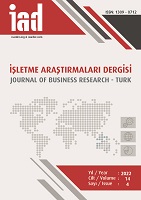Hile Tespitinde Makine Öğrenmesi Yöntemlerinin Kullanılması ve Model Performanslarının Değerlendirilmesi
Using Machine Learning Methods to Detect Fraud and Evaluation of Model Performances
Author(s): Önder Gür, Banu Tarhan MengiSubject(s): Business Economy / Management, ICT Information and Communications Technologies, Business Ethics, Socio-Economic Research
Published by: İşletme Araştırmaları Dergisi
Keywords: Detect Fraud; Machine Learning; Decision Tree;
Summary/Abstract: Purpose - It has been tried to produce a solution with technology-based tools to reduce the damage caused by fraud in this study. It is aimed to create a model with machine learning methods for the detection of fraudulent payments, which are frequently encountered in businesses. Design/methodology/approach - In the study, an artificial data set of 594.643 created with financial and non-financial information belonging to a bank was used. Using the data set, predictions were made with the Decision Tree, Support Vector Machine, Logistic Regression and Artificial Neural Networks methods of machine learning. Algorithms of the methods were first trained with 69% of the data set and then made predictions with 31% of the data set. Findings - Considering the values created by the methods, it was seen that the accuracy metric was 99.42% for Decision Tree, 99.11% for Support Vector Machine, 98.95% for Logistic Regression and 99.35% for Artificial Neural Networks. Decision tree was the method that predicted 1.620 fraudulent transactions correctly and made the most correct predictions and performed these processes in the fastest (1.32 seconds). According to the results, it has been determined that the decision tree is the model that makes the most successful, fastest and most accurate predictions on average. Discussion - Depending on the methods used in practice, machine learning methods produced false positive and false negative values in model trials with the data set. Although it is not possible to reduce these values to zero, it is open to development to reduce them.
Journal: İşletme Araştırmaları Dergisi
- Issue Year: 14/2022
- Issue No: 4
- Page Range: 3053-3065
- Page Count: 13
- Language: Turkish

